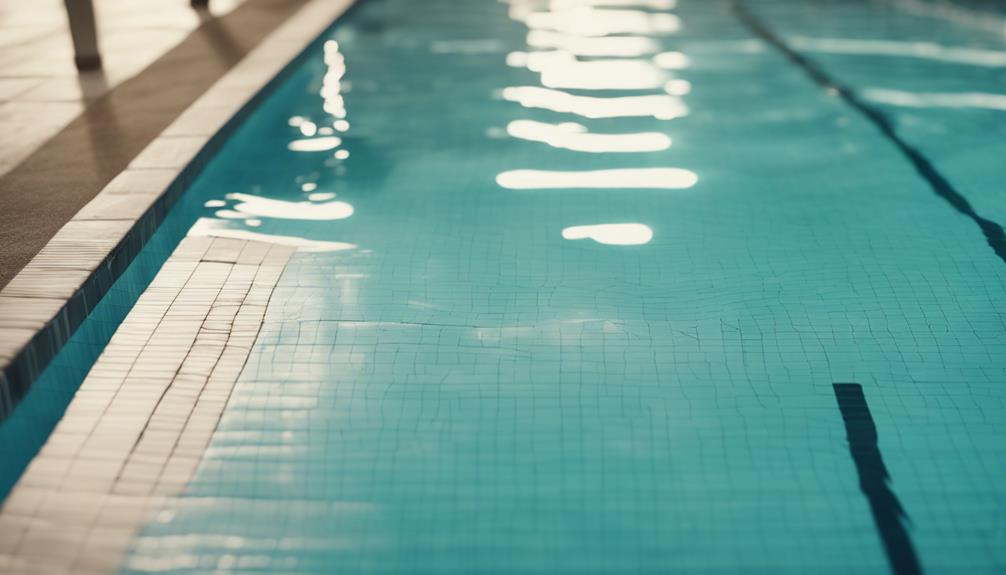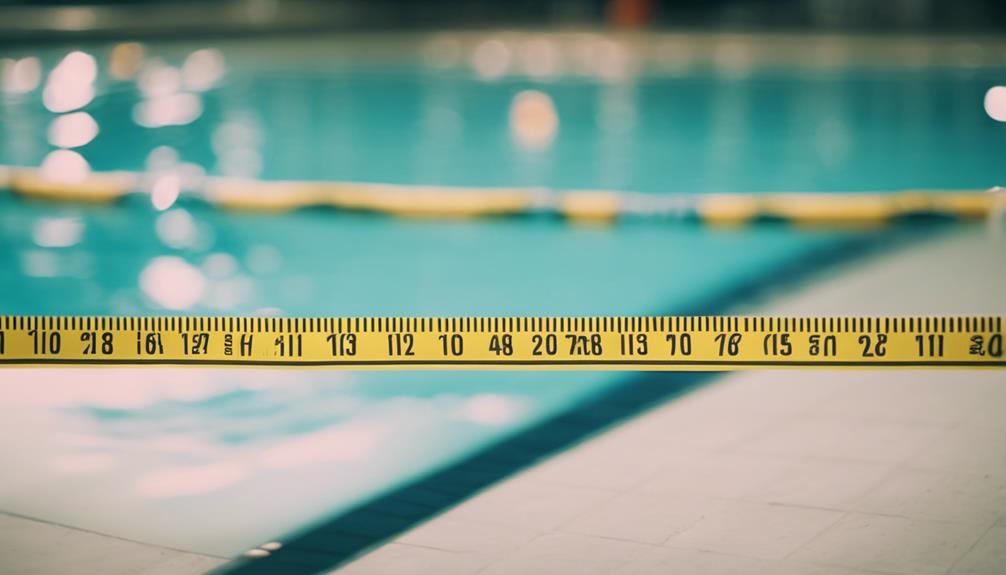To ensure accurate measurements of your swimming pool area, it is recommended to use a tape measure for precise dimensions. For rectangular pools, the formula Area = Length x Width can be applied. For circular pools, the formula A = Pi x r^2 is utilized by first dividing the diameter to find the radius, squaring it, and then multiplying by Pi. Dealing with irregular shapes may require breaking them down into smaller regular shapes to determine total capacity accurately. Understanding geometric formulas is essential for precise measurements. When assessing depth, take into consideration slopes and steps to maintain proper chemical balance and adhere to safety regulations. It is crucial to maintain precision in measurements for effective pool design and maintenance.
Key Takeaways
- Utilize geometric formulas for accurate area calculation.
- Divide the diameter by 2 to determine the radius.
- Square the radius and multiply by Pi for precise area.
- Break down irregular shapes into regular ones for measurement.
- Ensure depth measurements account for slopes and irregularities.
Rectangular Pool Area Calculation
To calculate the area of a rectangular pool, simply multiply the length by the width. This basic formula, Area = Length x Width, is fundamental for accurate area calculation.
When measuring the length and width of the pool, precision is key. Utilize a tape measure to guarantee exact dimensions, as even small discrepancies can lead to significant errors in area calculation.
Knowing the precise area of the pool is vital for determining the required amount of pool liner or surface materials. Additionally, understanding the surface area of a rectangular pool is essential for effective planning and designing of pool features and landscaping.
Circular Pool Area Calculation

To accurately calculate the area of a circular pool, understanding the points of radius calculation method is crucial. By knowing how to determine the radius and apply the area formula correctly, you guarantee accurate measurements for your pool.
Area formula derivation is another essential aspect to grasp. This formula is key to accurately determining the surface area of your circular pool. Understanding how this formula works will ensure precise calculations.
Practical application tips are also vital for accurate area calculations. These tips can help you avoid common mistakes and ensure that your pool's area is calculated correctly.
These points are fundamental in ensuring proper maintenance and accessories sizing for circular pools. Understanding them will lead to accurate measurements and a well-maintained pool.
Radius Calculation Method
Understanding how to calculate the radius for a circular pool is essential for accurately determining its area. To do this, follow these steps:
- Divide the Diameter: Start by dividing the diameter of the pool by 2 to find the radius.
- Square the Radius: Once you have the radius, square it by multiplying it by itself to get the squared value.
- Multiply by Pi: Next, multiply the squared radius by the mathematical constant Pi (3.14) to calculate the surface area of the circular pool.
- Use the Formula: Remember, the formula for the area of a circle is
A = Pi x r^2, where A represents the area and r is the radius.
Area Formula Derivation
Derive the formula for calculating the area of a circular pool by squaring the radius and multiplying by Pi. Understanding the derivation of the area formula is vital for accurately determining the space occupied by a circular pool.
By using the formula A = πr², where A represents the area and r is the radius of the pool, you can calculate the surface area efficiently. This formula is essential in pool construction and maintenance, as it helps in estimating the material needed for these tasks.
Accurate calculations of the circular pool area are necessary for designing pools that are both aesthetically pleasing and functional. Whether you're planning the layout of a new pool or ensuring proper maintenance, knowing the surface area of the pool is key to its efficiency.
Mastering the derivation of the circular pool area formula is the first step towards achieving precise measurements for various aspects of pool design and upkeep.
Practical Application Tips
Start by applying the formula A = πr² to calculate the area of a circular pool accurately.
To guarantee precision in measuring the area of the circular pool, follow these practical tips:
- Measure the diameter of the circular pool and divide it by 2 to determine the radius for accurate area calculation.
- Remember that the area formula for a circle involves multiplying π (Pi) by the square of the radius to determine the surface area correctly.
- For precise calculations, make sure the radius is half the diameter, and use the correct value of Pi (3.14) in your calculations.
- Understanding the area of the circular pool is essential for calculating water volume accurately and determining the necessary treatments for proper pool maintenance.
Irregular Pool Shape Area Calculation

Break down the irregular pool shape into smaller regular shapes like squares, rectangles, or circles to calculate its area accurately. By dividing the irregular pool into manageable regular shapes, such as squares and rectangles, you can guarantee precise measurements and calculations. This method allows you to measure and calculate the area of each regular shape separately, ensuring accuracy in determining the total capacity of the irregular pool. Precision in measurement is essential for obtaining accurate area calculations in irregular pool shapes. Treating the irregular pool as a combination of smaller regular shapes simplifies the area calculation process and helps in achieving precise results.
| Regular Shapes | Area Calculation |
|---|---|
| Square | Side length x Side length |
| Rectangle | Length x Width |
| Circle | π x (Radius x Radius) |
Geometric Formulas for Pool Area

When calculating swimming pool area, understanding geometric formulas is crucial. These formulas provide precise methods for determining pool area accurately. For squares or rectangles, the formula A = L x W is used. By applying the correct formula based on the pool shape, you can guarantee precise area measurements for maintenance and design purposes.
This understanding is essential as it ensures that the calculated area is accurate, which is important for various tasks such as adding chemicals, ordering pool covers, or planning landscaping around the pool.
Area Calculation Methods
To accurately calculate the area of a swimming pool, utilize geometric formulas such as A = L x W for square or rectangular pools and A = (L x W)/2 for right triangle pool shapes.
When determining the area of circular pools, remember to use the formula A = π x r x r to guarantee precise measurements.
Here are some key points to bear in mind when using geometric formulas for pool area calculations:
- Follow Specific Formulas: Different pool shapes require specific geometric formulas for accurate area calculations.
- Precision is Key: Ensure measurements are exact to obtain the correct pool area using geometric formulas.
- Consistency Matters: Maintain consistency in units of measurement when applying geometric formulas to calculate pool areas.
- Double-Check Calculations: Verify your calculations to avoid errors and make sure the pool area is accurately determined.
Understanding and applying these geometric formulas are essential for obtaining precise measurements and calculating swimming pool areas effectively.
Application in Design
Geometric formulas play a key role in the design process when calculating the area of swimming pools accurately. For rectangular pools, the formula A = L x W (length times width) is essential.
Circular pools require the formula A = π x r x r (pi times radius squared), where r represents the radius. Understanding the formula for the area of a right triangle, A = (L x W)/2, is important for calculating irregular pool shapes.
By applying these geometric formulas with precision, designers guarantee accurate measurements for creating pool areas. Additionally, these formulas aid in determining the surface area of pools, which is essential for volume calculations.
Whether designing rectangular pools with straight edges, circular pools with curves, or pools with irregular shapes, utilizing geometric formulas ensures precise and efficient calculations for achieving the desired pool area and volume.
Precision in Pool Depth Measurement

For accurate measurement of pool depth, consistently use a sturdy tape measure and check at multiple points around the pool.
Here are some tips for achieving precise pool depth measurements:
- Consider variations in depth: Due to slopes, steps, or irregular pool bottoms, depth measurements can vary. Be sure to account for these differences to get an exact reading.
- Calculate an average depth: Add all depth measurements taken at various points around the pool and divide by the total number of measurements. This will give you a more accurate average depth.
- Importance of accurate pool depth measurements: Ensuring precise depth measurements is vital for calculating the pool's capacity, maintaining chemical balance, selecting equipment sizes, and complying with safety regulations.
- Understanding pool shapes: Different pool shapes can impact depth measurements. Familiarize yourself with the pool's shape to make accurate readings and ensure proper maintenance and water treatment.
Calculating Volume for Pool Maintenance

Understanding the volume of your swimming pool is essential for efficient maintenance and chemical balance. To calculate the volume accurately, you need to take into account the pool's shape, average depth, and water depth.
Pool volume calculators can help in determining the total water capacity, aiding in selecting the right equipment and features for ideal operation. Additionally, knowing the pool volume is critical for proper chemical treatment, as it assists in determining the correct amount of chemicals required to maintain water quality.
Furthermore, precise volume calculations play a significant role in ensuring pool safety and compliance with lifeguard requirements. By accurately measuring the pool volume, you can establish the necessary safety features and lifeguard ratios to maintain a secure swimming environment.
Hence, incorporating pool volume calculations into your pool maintenance routine is essential for both the longevity of the pool and the well-being of swimmers.
Frequently Asked Questions
How to Calculate the Area of a Swimming Pool?
To calculate the area of a swimming pool, start by determining the pool's shape.
For rectangular pools, multiply the length by the width.
Circular pools require using the formula A = πr², where r is the radius.
Irregular pools may need breaking down into smaller regular shapes.
Accurate measurements are essential for maintenance, equipment selection, and chemical dosing.
Understanding this process helps in choosing appropriate pool covers, liners, and maintenance tools.
What Measurement Would You Use to Measure a Swimming Pool?
To measure a swimming pool accurately, use a tape measure inside the pool walls for length and width. Avoid top rails or outer edges for precise dimensions.
Measure the pool depth at various points to calculate an average depth. For circular pools, measure the diameter to find the radius for volume calculations.
Accurate measurements are crucial for fitting liners, covers, and other pool accessories properly. Follow these steps to guarantee precise measurements every time.
How Do You Measure Pool Space?
To measure pool space accurately, start by obtaining the length and width measurements inside the pool walls.
For oval pools, find the midpoint and measure the width precisely.
Be sure to measure the entire wall height from top to bottom for proper liner fitting.
Avoid measuring from the top rail and assess circularity from various angles in round pools.
Precision is key to prevent fitting issues and guarantee correct equipment selection.
Which Unit of Measurement Would You Prefer to Find the Area of Swimming Pool?
When determining the area of a swimming pool, the unit of measurement you should prefer depends on the pool's size and intended use.
For smaller residential pools, square feet are like a familiar old friend, offering a detailed comparison to household spaces.
If you seek international compatibility and precision, square meters serve as a dependable companion, ensuring seamless communication on a global scale.
For vast commercial pools, acres stand tall, providing an extensive perspective on size.
Is the Calculation for Swimming Pool Area the Same as Calculating Square Meters?
When calculating swimming pool area square meters, you use the same formula as you would for any other space. Measure the length and width of the pool, then multiply the two numbers together to get the total square meters. Make sure to account for any irregular shapes or additional features.
How Does Measuring the Length of a Swimming Pool Help in Calculating the Pool Area?
When measuring swimming pool length, you can use that measurement to calculate the pool area. By multiplying the length of the pool by the width, you can determine the total area. This is essential for knowing how much space you have for pool activities and for maintenance purposes.
Conclusion
In summary, accurately calculating the area of a swimming pool is essential for proper maintenance and safety. By following precise measurements and utilizing geometric formulas, you can guarantee your pool is in top-notch condition.
Remember, precision in measurement is key to maintaining a healthy and enjoyable swimming environment. So, next time you're calculating your pool area, take the time to do it right and enjoy a clean and well-maintained pool all season long.










